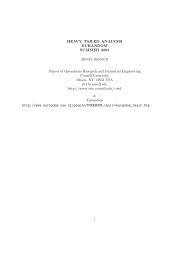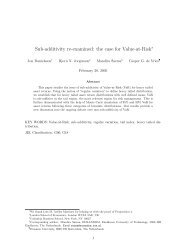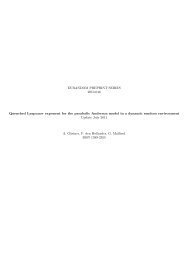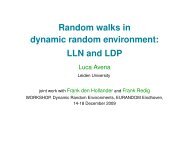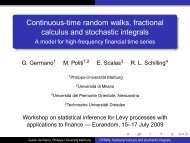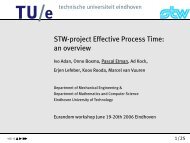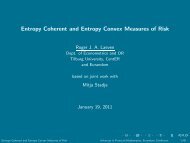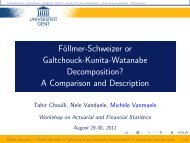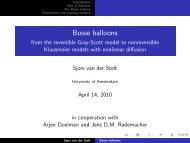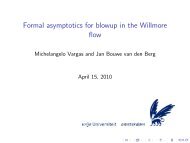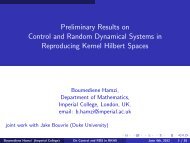The Contraction Method on C([0,1]) and Donsker's ... - Eurandom
The Contraction Method on C([0,1]) and Donsker's ... - Eurandom
The Contraction Method on C([0,1]) and Donsker's ... - Eurandom
Create successful ePaper yourself
Turn your PDF publications into a flip-book with our unique Google optimized e-Paper software.
Proof of D<strong>on</strong>sker’s <str<strong>on</strong>g>The</str<strong>on</strong>g>orem (Sketch)<br />
We are in the case 2 < s < 3 <strong>and</strong> have to c<strong>on</strong>sider E[f (X , X )] for<br />
c<strong>on</strong>tinuous, bilinear functi<strong>on</strong>s f : C([0, 1]) 2 → R.<br />
This is d<strong>on</strong>e by c<strong>on</strong>trolling the covariance functi<strong>on</strong>.<br />
Since S n <strong>and</strong> B do not share their covariance functi<strong>on</strong> (of course<br />
E[S n s , S n t ] → min(s, t)) we also c<strong>on</strong>sider the process B n defined by<br />
B n t = B ⌊nt⌋<br />
n<br />
B<br />
−1.0 −0.5 0.0 0.5 1.0<br />
+ (nt − ⌊nt⌋)<br />
<br />
B ⌊nt⌋+1<br />
n<br />
− B ⌊nt⌋<br />
n<br />
Henning Sulzbach J. W. Goethe-Universität Frankfurt a. M. <str<strong>on</strong>g>The</str<strong>on</strong>g> <str<strong>on</strong>g>C<strong>on</strong>tracti<strong>on</strong></str<strong>on</strong>g> <str<strong>on</strong>g>Method</str<strong>on</strong>g> <strong>on</strong> C([0, 1]) <strong>and</strong> D<strong>on</strong>sker’s <str<strong>on</strong>g>The</str<strong>on</strong>g>orem<br />
<br />
.


![The Contraction Method on C([0,1]) and Donsker's ... - Eurandom](https://img.yumpu.com/19554492/53/500x640/the-contraction-method-on-c01-and-donskers-eurandom.jpg)
